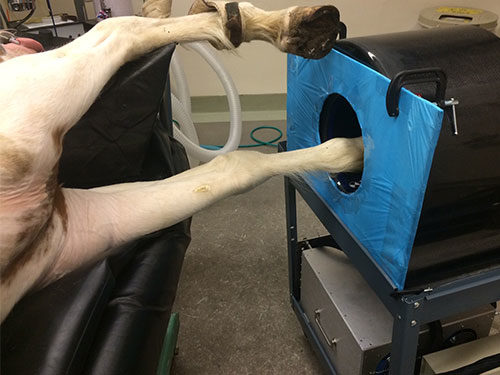Pictured Above: UC Davis’ new portable PET scanner is the first of its kind to be used to image horses.
The University of California-Davis veterinary hospital recently acquired a positron emission tomography (PET) scanner, becoming the first veterinary facility in the world to utilize the imaging technology for equine patients.
In association with the UC Davis School of Veterinary Medicine’s Center for Equine Health (CEH), the hospital will launch use of the PET scanner in the summer 2016. The unit has been acquired for research and clinical studies on lameness diagnosis in horses.
While most other imaging techniques provide “morphological” information (identifying changes in size, shape or density of structures), PET is a “functional” imaging technique, observing activity at the molecular level — detecting changes in the tissue before the size or shape is modified. Once morphological changes have occurred, PET can tell whether the changes are still active.
“In practicality, that means two things,” says Mathieu Spriet, a UC Davis veterinary radiologist. “One, PET can detect lesions that other advanced modalities do not identify, and two, it can tell us if a lesion — identified with another modality — is a significant injury or not.”
The equine PET scanner has produced initial data — obtained last year at UC Davis during a research project using a prototype of the new scanner — that demonstrates great success for bone imaging. The project revealed several PET capabilities for equine imaging:
• Identified small areas of bone remodeling at the attachment of tendons or ligaments missed with other modalities.
• Showed increased activity in bone adjacent to joints, where degenerative changes are known to occur, before morphological changes were present.
• Revealed increased activity in some joint fragments whereas other joint fragments appeared quiet.
• Demonstrated that some areas of bone proliferation were active, whereas others were quiescent.
“Preliminary data suggests that PET will be the next big revolution in equine imaging since the development of MRI,” Spriet says.
In order to confirm these findings and further define the role of PET in lameness imaging, UC Davis will launch a clinical trial in the fall 2016. Horses likely to benefit from enrollment in the trial are:
• Horses for which other advanced imaging modalities (MRI, CT or nuclear scintigraphy) have failed to identify the cause of the lameness.
• Horses for which the results of other imaging modalities are confusing due to the presence of multiple abnormalities or equivocal findings.
PET also has shown great promises in evaluating soft tissue lesions, in particular regarding laminitis and tendon lesions. Research studies gathering further information in these specific areas will commence shortly at UC Davis. As more data becomes available, additional clinical trials likely will develop.







